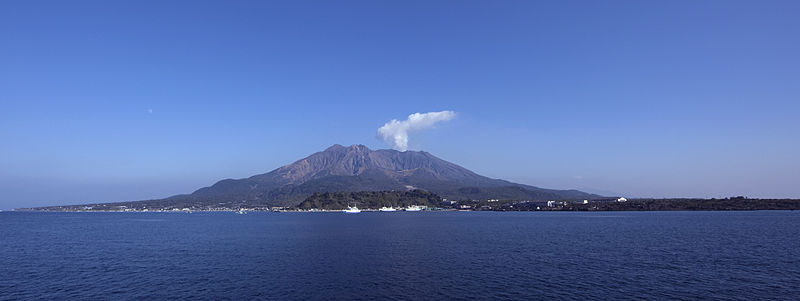Explosive eruptions at Sakurajima volcano, Japan

Couple explosive eruption have been recorded at Sakurajima volcano in Japan. Sakura-jima, one of Japan’s most active volcanoes, is a post-caldera cone of the Aira caldera at the northern half of Kagoshima Bay. Eruption of the voluminous Ito pyroclastic flow was associated with the formation of the 17 x 23-km-wide Aira caldera about 22,000 years ago.
Sakurajima’s activity became prominent in 1955, and the volcano has been erupting almost constantly ever since. Thousands of small explosions occur each year, throwing ash to heights of up to a few kilometers above the mountain. The Sakurajima Volcano Observatory was set up in 1960 to monitor these eruptions.

The construction of Sakura-jima began about 13,000 years ago and built an island that was finally joined to the Osumi Peninsula during the major explosive and effusive eruption of 1914. Activity at the Kita-dake summit cone ended about 4,850 years ago, after which eruptions took place at Minami-dake. Frequent historical eruptions, recorded since the 8th century, have deposited ash on Kagoshima, one of Kyushu’s largest cities, located across Kagoshima Bay only 8 km from the summit. The largest historical eruption took place during 1471-76. The volcano type is VE4 (Volcanic Explosivity Index). (GVP)




The 1914 eruption was the most powerful in twentieth-century Japan. Lava flows filled the narrow strait between the island and the mainland, turning it into a peninsula. The volcano had been dormant for over a century until 1914.The 1914 eruption began on January 11. Almost all residents had left the island in the previous days, in response to several large earthquakes that warned them that an eruption was imminent. Initially, the eruption was very explosive, generating eruption columns and pyroclastic flows, but after a very large earthquake on January 13, 1914 which killed 35 people, it became effusive, generating a large lava flow. Lava flows are rare in Japan—the high silica content of the magmas there mean that explosive eruptions are far more common but the lava flows at Sakurajima continued for months.
Pre-eruption earthquakes killed at least 35 people; caused an evacuation and significant changes to the local topology. The island grew, engulfing several smaller islands nearby, and eventually becoming connected to the mainland by a narrow isthmus. Parts of Kagoshima bay became significantly shallower, and tides were affected, becoming higher as a result.
During the final stages of the eruption, the centre of the Aira Caldera sank by about 60 centimetres (24 in), due to subsidence caused by the emptying out of the underlying magma chamber. The fact that the subsidence occurred at the centre of the caldera rather than directly underneath Sakurajima showed that the volcano draws its magma from the same reservoir that fed the ancient caldera-forming eruption. The eruption partly inspired a 1914 movie, Wrath of the Gods, centering around a family curse that ostensibly causes the eruption. The city of Kagoshima was covered by deep ash during the 1914 eruption of the Sakurajima, which is visible across the bay. (EarthquakeReport)

Commenting rules and guidelines
We value the thoughts and opinions of our readers and welcome healthy discussions on our website. In order to maintain a respectful and positive community, we ask that all commenters follow these rules.